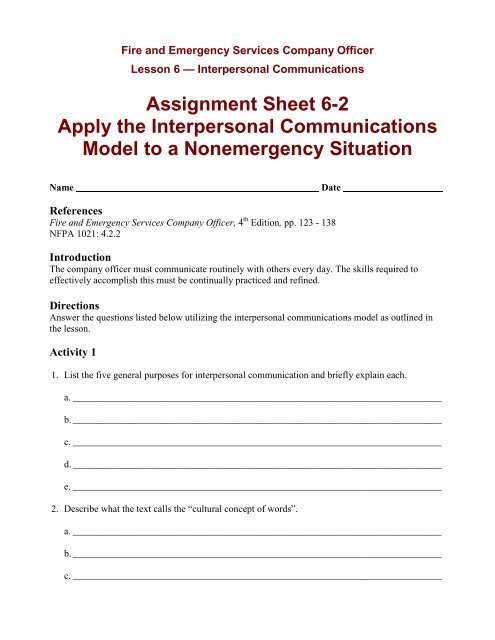Assignment Sheet 6-2, Apply the Interpersonal Communications ...
Assignment Sheet 6-2, Apply the Interpersonal Communications ...
Assignment Sheet 6-2, Apply the Interpersonal Communications ...
Create successful ePaper yourself
Turn your PDF publications into a flip-book with our unique Google optimized e-Paper software.
Fire and Emergency Services Company Officer<br />
Lesson 6 — <strong>Interpersonal</strong> <strong>Communications</strong><br />
<strong>Assignment</strong> <strong>Sheet</strong> 6-2<br />
<strong>Apply</strong> <strong>the</strong> <strong>Interpersonal</strong> <strong>Communications</strong><br />
Model to a Nonemergency Situation<br />
Name<br />
Date<br />
References<br />
Fire and Emergency Services Company Officer, 4 th Edition, pp. 123 - 138<br />
NFPA 1021: 4.2.2<br />
Introduction<br />
The company officer must communicate routinely with o<strong>the</strong>rs every day. The skills required to<br />
effectively accomplish this must be continually practiced and refined.<br />
Directions<br />
Answer <strong>the</strong> questions listed below utilizing <strong>the</strong> interpersonal communications model as outlined in<br />
<strong>the</strong> lesson.<br />
Activity 1<br />
1. List <strong>the</strong> five general purposes for interpersonal communication and briefly explain each.<br />
a. ____________________________________________________________________________<br />
b. ____________________________________________________________________________<br />
c. ____________________________________________________________________________<br />
d. ____________________________________________________________________________<br />
e. ____________________________________________________________________________<br />
2. Describe what <strong>the</strong> text calls <strong>the</strong> “cultural concept of words”.<br />
a. ____________________________________________________________________________<br />
b. ____________________________________________________________________________<br />
c. ____________________________________________________________________________
d. ____________________________________________________________________________<br />
e. ____________________________________________________________________________<br />
3. List three nonverbal clues described in <strong>the</strong> text that may overpower <strong>the</strong> verbal message.<br />
a. ____________________________________________________________________________<br />
b. ____________________________________________________________________________<br />
c. ____________________________________________________________________________<br />
4. Explain <strong>the</strong> strategies that a company officer can explore to improve personal nonverbal<br />
communications skills.<br />
a. ____________________________________________________________________________<br />
b. ____________________________________________________________________________<br />
c. ____________________________________________________________________________<br />
d. ____________________________________________________________________________<br />
e. ____________________________________________________________________________<br />
f. ____________________________________________________________________________<br />
g. ____________________________________________________________________________<br />
h. ____________________________________________________________________________<br />
i. ____________________________________________________________________________
Activity 2<br />
The routine of <strong>the</strong> fire station requires that certain duties or jobs be performed on a regular basis. The<br />
company officer, as supervisor, is responsible for <strong>the</strong> initiation, conduct and completion of <strong>the</strong>se<br />
actions. Company officers must also continually motivate <strong>the</strong>ir personnel to perform <strong>the</strong>se tasks. To<br />
accomplish this, <strong>the</strong> company officer must utilize extensive interpersonal communication skills to<br />
direct <strong>the</strong> assigned personnel. The following scenarios represent typical routine station<br />
communications and assignments. Utilizing <strong>the</strong> communications skills presented in lesson 6, answer<br />
<strong>the</strong> questions that follow each of <strong>the</strong> nonemergency scenarios as <strong>the</strong>y relate to <strong>the</strong> interpersonal<br />
communications skills required of a company officer.<br />
Scenario 1<br />
Battalion Chief McCardle has visited your station and discussed with you a change in procedures<br />
regarding <strong>the</strong> morning inspection and maintenance checks that are to be performed by all company<br />
members on <strong>the</strong>ir personal protective equipment (PPE). She advises that <strong>the</strong>se procedures supersede<br />
those currently in use. You are to convey <strong>the</strong>se new procedures to your crew just prior to shift change<br />
checks next shift.<br />
5. Who is <strong>the</strong> sender?<br />
_____________________________________________________________________________<br />
6. What are <strong>the</strong> main points of <strong>the</strong> message that must be communicated?<br />
a. ____________________________________________________________________________<br />
b. ____________________________________________________________________________<br />
c. ____________________________________________________________________________<br />
7. How is <strong>the</strong> message transmitted?<br />
_____________________________________________________________________________<br />
8. What is its medium of <strong>the</strong> message?<br />
_____________________________________________________________________________<br />
9. Who is/are <strong>the</strong> receiver(s)?<br />
_____________________________________________________________________________
Scenario 2<br />
As a company officer it is your responsibility to insure that all equipment is in a “ready” condition. A<br />
new directive regarding <strong>the</strong> procedures to be used during <strong>the</strong> change of shift inspection of personal<br />
protective equipment (PPE) has been issued by <strong>the</strong> Operations Chief of <strong>the</strong> department. Prior to <strong>the</strong><br />
shift change inspection, you ga<strong>the</strong>r <strong>the</strong> company toge<strong>the</strong>r to instruct <strong>the</strong>m about <strong>the</strong>se new<br />
procedures. After reviewing <strong>the</strong>m with <strong>the</strong> crew, you ask <strong>the</strong> company if <strong>the</strong>re are any questions.<br />
Once all questions have been addressed, company members are assigned to conduct <strong>the</strong>ir equipment<br />
and maintenance checks.<br />
10. Who is/are <strong>the</strong> receiver(s)?<br />
_____________________________________________________________________________<br />
11. Who is <strong>the</strong> sender?<br />
_____________________________________________________________________________<br />
12. List <strong>the</strong> main points of <strong>the</strong> message that must be communicated.<br />
a. ____________________________________________________________________________<br />
b. ____________________________________________________________________________<br />
c. ____________________________________________________________________________<br />
13. How is <strong>the</strong> message transmitted?<br />
_____________________________________________________________________________<br />
14. What is <strong>the</strong> medium that is used to convey <strong>the</strong> message.<br />
_____________________________________________________________________________<br />
15. Describe <strong>the</strong> possible sources of interference that may prevent <strong>the</strong> receiver from fully receiving<br />
<strong>the</strong> message. Categorize <strong>the</strong>se sources as ei<strong>the</strong>r internal or external in nature.<br />
a. ____________________________________________________________________________<br />
b. ____________________________________________________________________________<br />
16. Is feedback necessary? If required, describe what feedback would be appropriate.<br />
_____________________________________________________________________________
Scenario 3<br />
Battalion Chief McCardle telephoned you at 1030 hours regarding a fire hydrant that had all of it<br />
caps removed. The hydrant is located in your primary response area at <strong>the</strong> intersection of Walnut and<br />
Spruce Streets. You call firefighter Brown to your office and order her to take <strong>the</strong> company utility<br />
truck and check <strong>the</strong> status of <strong>the</strong> hydrant. Additionally, you instruct firefighter Brown to replace <strong>the</strong><br />
caps if <strong>the</strong>y are still with <strong>the</strong> hydrant or should <strong>the</strong>y not be <strong>the</strong>re drive to Water Services Department<br />
and get replacements. Firefighter Brown is to notify you by radio if <strong>the</strong>re are o<strong>the</strong>r problems<br />
associated with <strong>the</strong> fire hydrant.<br />
17. Who is <strong>the</strong> sender in this scenario?<br />
_____________________________________________________________________________<br />
18. Who is <strong>the</strong> receiver?<br />
_____________________________________________________________________________<br />
19. How is <strong>the</strong> message transmitted?<br />
_____________________________________________________________________________<br />
20. What medium is used to convey <strong>the</strong> message?<br />
_____________________________________________________________________________<br />
21. Describe <strong>the</strong> possible sources of interference that may prevent <strong>the</strong> receiver from fully receiving<br />
<strong>the</strong> message. Categorize <strong>the</strong>se sources as ei<strong>the</strong>r internal or external in nature.<br />
a. ____________________________________________________________________________<br />
b. ____________________________________________________________________________<br />
c. ____________________________________________________________________________<br />
d. ____________________________________________________________________________<br />
e. ____________________________________________________________________________






